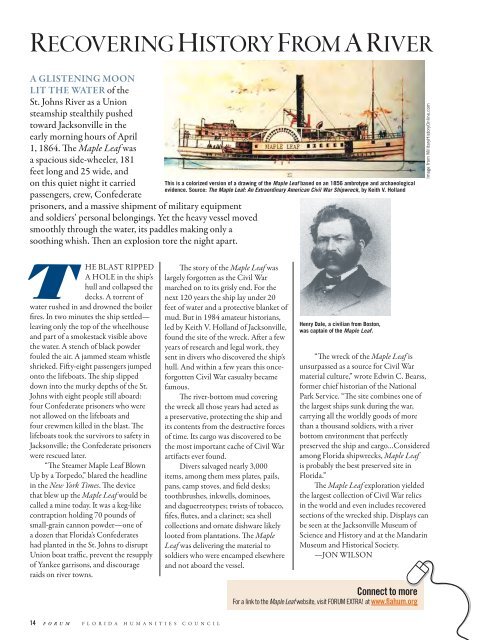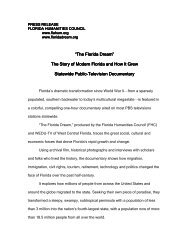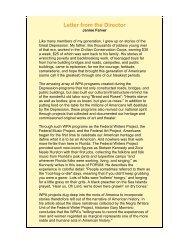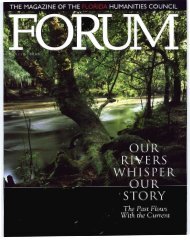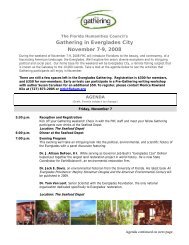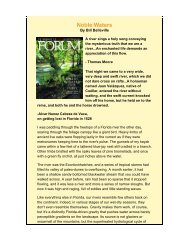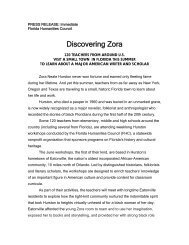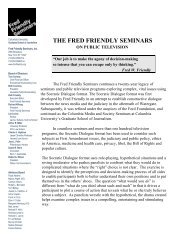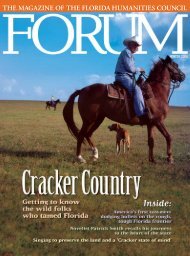when florida “Opened up the gates of hell” - Florida Humanities ...
when florida “Opened up the gates of hell” - Florida Humanities ...
when florida “Opened up the gates of hell” - Florida Humanities ...
You also want an ePaper? Increase the reach of your titles
YUMPU automatically turns print PDFs into web optimized ePapers that Google loves.
REcoVERINg HIsToRy fRom a RIVER<br />
A GLISTENING MOON<br />
LIT THE wATER <strong>of</strong> <strong>the</strong><br />
St. Johns River as a Union<br />
steamship stealthily pushed<br />
toward Jacksonville in <strong>the</strong><br />
early morning hours <strong>of</strong> April<br />
1, 1864. The Maple Leaf was<br />
a spacious side-wheeler, 181<br />
feet long and 25 wide, and<br />
on this quiet night it carried<br />
passengers, crew, Confederate<br />
prisoners, and a massive shipment <strong>of</strong> military equipment<br />
and soldiers’ personal belongings. Yet <strong>the</strong> heavy vessel moved<br />
smoothly through <strong>the</strong> water, its paddles making only a<br />
soothing whish. Then an explosion tore <strong>the</strong> night apart.<br />
THE BLAST RIPPED<br />
A HOLE in <strong>the</strong> ship’s<br />
hull and collapsed <strong>the</strong><br />
decks. A torrent <strong>of</strong><br />
water rushed in and drowned <strong>the</strong> boiler<br />
fires. In two minutes <strong>the</strong> ship settled—<br />
leaving only <strong>the</strong> top <strong>of</strong> <strong>the</strong> wheelhouse<br />
and part <strong>of</strong> a smokestack visible above<br />
<strong>the</strong> water. A stench <strong>of</strong> black powder<br />
fouled <strong>the</strong> air. A jammed steam whistle<br />
shrieked. Fifty-eight passengers jumped<br />
onto <strong>the</strong> lifeboats. The ship slipped<br />
down into <strong>the</strong> murky depths <strong>of</strong> <strong>the</strong> St.<br />
Johns with eight people still aboard:<br />
four Confederate prisoners who were<br />
not allowed on <strong>the</strong> lifeboats and<br />
four crewmen killed in <strong>the</strong> blast. The<br />
lifeboats took <strong>the</strong> survivors to safety in<br />
Jacksonville; <strong>the</strong> Confederate prisoners<br />
were rescued later.<br />
“The Steamer Maple Leaf Blown<br />
Up by a Torpedo,” blared <strong>the</strong> headline<br />
in <strong>the</strong> New York Times. The device<br />
that blew <strong>up</strong> <strong>the</strong> Maple Leaf would be<br />
called a mine today. It was a keg-like<br />
contraption holding 70 pounds <strong>of</strong><br />
small-grain cannon powder—one <strong>of</strong><br />
a dozen that <strong>Florida</strong>’s Confederates<br />
had planted in <strong>the</strong> St. Johns to disr<strong>up</strong>t<br />
Union boat traffic, prevent <strong>the</strong> res<strong>up</strong>ply<br />
<strong>of</strong> Yankee garrisons, and discourage<br />
raids on river towns.<br />
14 F O R U M F L O R I D A H U M A N I T I E S C O U N C I L<br />
This is a colorized version <strong>of</strong> a drawing <strong>of</strong> <strong>the</strong> Maple Leaf based on an 1856 ambrotype and archaeological<br />
evidence. Source: The Maple Leaf: An Extraordinary American Civil War Shipwreck, by Keith V. Holland<br />
The story <strong>of</strong> <strong>the</strong> Maple Leaf was<br />
largely forgotten as <strong>the</strong> Civil War<br />
marched on to its grisly end. For <strong>the</strong><br />
next 120 years <strong>the</strong> ship lay under 20<br />
feet <strong>of</strong> water and a protective blanket <strong>of</strong><br />
mud. But in 1984 amateur historians,<br />
led by Keith V. Holland <strong>of</strong> Jacksonville,<br />
found <strong>the</strong> site <strong>of</strong> <strong>the</strong> wreck. After a few<br />
years <strong>of</strong> research and legal work, <strong>the</strong>y<br />
sent in divers who discovered <strong>the</strong> ship’s<br />
hull. And within a few years this onceforgotten<br />
Civil War casualty became<br />
famous.<br />
The river-bottom mud covering<br />
<strong>the</strong> wreck all those years had acted as<br />
a preservative, protecting <strong>the</strong> ship and<br />
its contents from <strong>the</strong> destructive forces<br />
<strong>of</strong> time. Its cargo was discovered to be<br />
<strong>the</strong> most important cache <strong>of</strong> Civil War<br />
artifacts ever found.<br />
Divers salvaged nearly 3,000<br />
items, among <strong>the</strong>m mess plates, pails,<br />
pans, camp stoves, and field desks;<br />
toothbrushes, inkwells, dominoes,<br />
and daguerreotypes; twists <strong>of</strong> tobacco,<br />
fifes, flutes, and a clarinet; sea shell<br />
collections and ornate dishware likely<br />
looted from plantations. The Maple<br />
Leaf was delivering <strong>the</strong> material to<br />
soldiers who were encamped elsewhere<br />
and not aboard <strong>the</strong> vessel.<br />
Henry Dale, a civilian from Boston,<br />
was captain <strong>of</strong> <strong>the</strong> Maple Leaf.<br />
“The wreck <strong>of</strong> <strong>the</strong> Maple Leaf is<br />
unsurpassed as a source for Civil War<br />
material culture,” wrote Edwin C. Bearss,<br />
former chief historian <strong>of</strong> <strong>the</strong> National<br />
Park Service. “The site combines one <strong>of</strong><br />
<strong>the</strong> largest ships sunk during <strong>the</strong> war,<br />
carrying all <strong>the</strong> worldly goods <strong>of</strong> more<br />
than a thousand soldiers, with a river<br />
bottom environment that perfectly<br />
preserved <strong>the</strong> ship and cargo…Considered<br />
among <strong>Florida</strong> shipwrecks, Maple Leaf<br />
is probably <strong>the</strong> best preserved site in<br />
<strong>Florida</strong>.”<br />
The Maple Leaf exploration yielded<br />
<strong>the</strong> largest collection <strong>of</strong> Civil War relics<br />
in <strong>the</strong> world and even includes recovered<br />
sections <strong>of</strong> <strong>the</strong> wrecked ship. Displays can<br />
be seen at <strong>the</strong> Jacksonville Museum <strong>of</strong><br />
Science and History and at <strong>the</strong> Mandarin<br />
Museum and Historical Society.<br />
—JON WILSON<br />
Connect to more<br />
For a link to <strong>the</strong> Maple Leaf website, visit FORUM EXTRA! at www.flahum.org<br />
Image from MilitaryHistoryOnline.com


